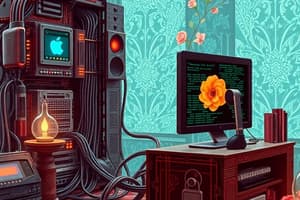Podcast
Questions and Answers
What is the primary function of the Central Processing Unit (CPU) in a computer?
What is the primary function of the Central Processing Unit (CPU) in a computer?
- Stores information for future access.
- Provides a user interface for applications.
- Communicates with other devices over a network.
- Executes instructions and processes data. (correct)
Which of the following best describes application software?
Which of the following best describes application software?
- Operating systems that control devices.
- Programs that manage hardware resources.
- Software designed for network security.
- Programs designed for end-users to perform specific tasks. (correct)
What distinguishing feature defines supercomputers?
What distinguishing feature defines supercomputers?
- They process large amounts of data for complex computations. (correct)
- They are portable and suitable for personal use.
- They provide basic services to a network.
- They mainly operate within a local area network.
What is the role of a firewall in computer security?
What is the role of a firewall in computer security?
Which type of network connects computers across broader areas, such as across cities or countries?
Which type of network connects computers across broader areas, such as across cities or countries?
What is a function of system software?
What is a function of system software?
Which generation of computers used vacuum tubes for processing?
Which generation of computers used vacuum tubes for processing?
Which of the following is considered an input device?
Which of the following is considered an input device?
Flashcards are hidden until you start studying
Study Notes
Definition
- A computer is an electronic device capable of processing data, performing calculations, and executing stored instructions.
Main Components
-
Hardware
- Central Processing Unit (CPU): The brain of the computer; executes instructions.
- Memory (RAM): Temporary storage for data and programs currently in use.
- Storage: Long-term data storage (e.g., Hard Disk Drives (HDD), Solid State Drives (SSD)).
- Input Devices: Tools for data entry (e.g., keyboard, mouse).
- Output Devices: Devices that output processed data (e.g., monitor, printer).
-
Software
- System Software: Includes operating systems (e.g., Windows, macOS, Linux) that manage hardware and software resources.
- Application Software: Programs designed for end-users (e.g., word processors, spreadsheets).
Types of Computers
- Personal Computers (PCs): Designed for individual use; includes desktops and laptops.
- Mobile Devices: Portable computers; includes smartphones and tablets.
- Servers: Powerful systems providing services and resources to other computers over a network.
- Mainframes: Large, powerful computers used mainly by enterprises to process large amounts of data.
- Supercomputers: Extremely powerful machines used for complex computations in fields like climate modeling and simulations.
Functions
- Data Processing: Receiving data, processing it, and outputs results.
- Data Storage and Retrieval: Storing information for future access.
- Communication: Connecting to networks (e.g., internet) to facilitate information exchange.
Networking
- Local Area Network (LAN): Connects computers in a limited area (e.g., home, office).
- Wide Area Network (WAN): Covers larger geographic areas (e.g., the Internet).
- Network Protocols: Rules governing data transmission (e.g., TCP/IP).
Security
- Antivirus Software: Protects against malware and viruses.
- Firewalls: Monitors and controls incoming and outgoing network traffic.
- Encryption: Secures data by transforming it into unreadable formats for unauthorized users.
Evolution
- Generations of Computers: Classified into five generations based on technological advances, from vacuum tubes to modern microprocessors.
Impact
- Transforms industries through automation and data analysis.
- Facilitates communication and information sharing globally.
- Drives innovation in various fields, including science, education, and entertainment.
Computer Definition
- An electronic device that processes data, performs calculations, and executes instructions.
Hardware Components
- CPU: The brain of a computer, responsible for executing instructions.
- RAM: Used for temporary data and program storage while in use.
- Storage: Long-term storage for data (e.g., HDD, SSD).
- Input Devices: Devices used to enter data (e.g., keyboard, mouse).
- Output Devices: Devices that display or output processed data (e.g., monitor, printer).
Software
- System Software: Manages hardware and software resources (e.g., operating systems like Windows, macOS, Linux).
- Application Software: Programs designed for specific tasks by users (e.g., word processors, spreadsheets).
Computer Types
- Personal Computers (PCs): For individual use, including desktops and laptops.
- Mobile Devices: Portable computers like smartphones and tablets.
- Servers: Powerful computers that provide services and resources to other computers over a network.
- Mainframes: Large, powerful systems used by enterprises for processing massive amounts of data.
- Supercomputers: Extremely powerful machines used for complex computations in fields like climate modeling.
Computer Functions
- Data Processing: Receiving, processing, and outputting data.
- Data Storage and Retrieval: Storing and accessing information.
- Communication: Connecting to networks like the internet for information exchange.
Networking
- LAN: Connects computers within a limited area (e.g., home, office).
- WAN: Connects computers over a wide geographic area (e.g., the internet).
- Network Protocols: Rules governing data transmission over networks (e.g., TCP/IP).
Security
- Antivirus Software: Protects against malware and viruses.
- Firewalls: Monitor and control incoming and outgoing network traffic.
- Encryption: Secures data by transforming it into unreadable formats for unauthorized users.
Computer Evolution
- Generations: Classified into five generations based on technological advancements, from vacuum tubes to modern microprocessors.
Impact of Computers
- Industrial Transformation: Automation and data analysis drive changes in industries.
- Enhanced Communication: Facilitates information sharing and global communication.
- Innovation: Drives advancements in diverse fields like science, education, and entertainment.
Studying That Suits You
Use AI to generate personalized quizzes and flashcards to suit your learning preferences.




